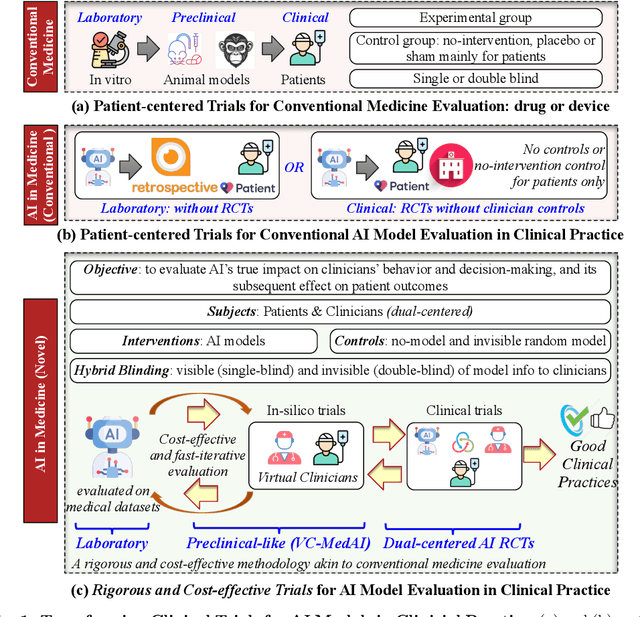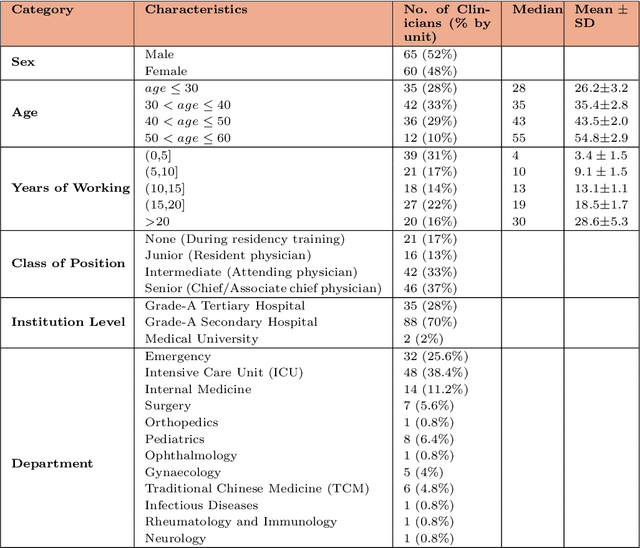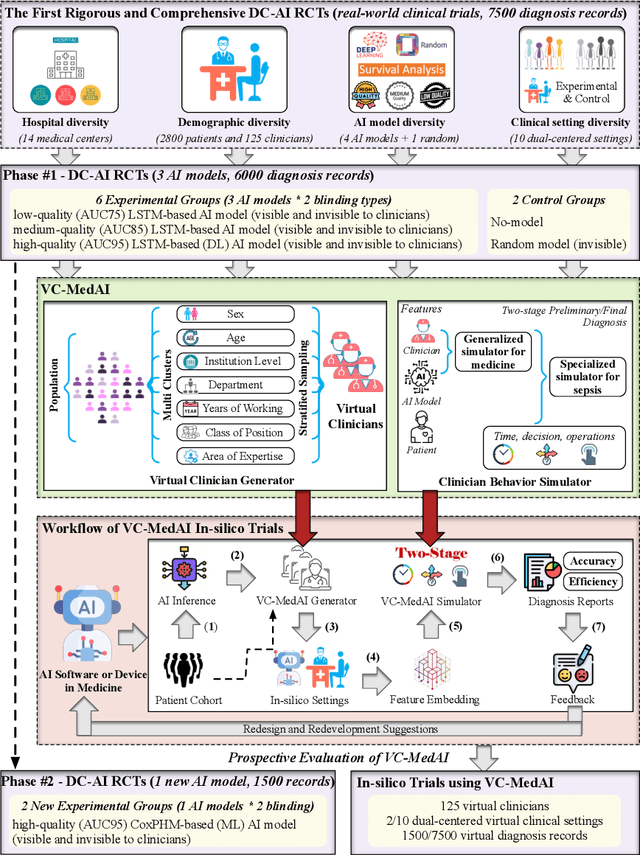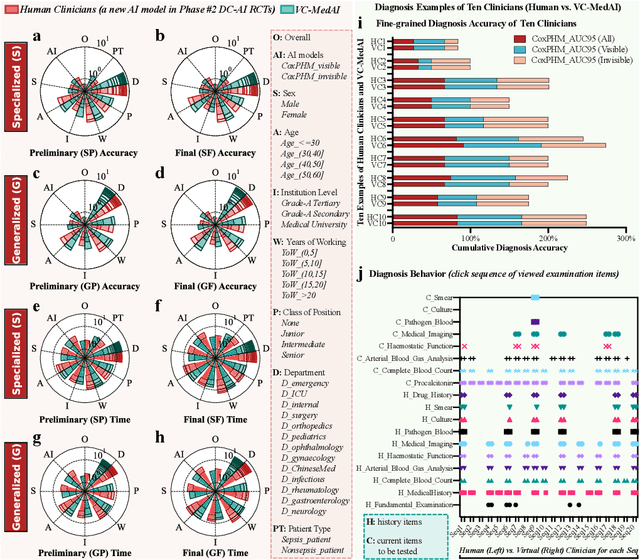Tianyi Wei
FreeFlux: Understanding and Exploiting Layer-Specific Roles in RoPE-Based MMDiT for Versatile Image Editing
Mar 20, 2025Abstract:The integration of Rotary Position Embedding (RoPE) in Multimodal Diffusion Transformer (MMDiT) has significantly enhanced text-to-image generation quality. However, the fundamental reliance of self-attention layers on positional embedding versus query-key similarity during generation remains an intriguing question. We present the first mechanistic analysis of RoPE-based MMDiT models (e.g., FLUX), introducing an automated probing strategy that disentangles positional information versus content dependencies by strategically manipulating RoPE during generation. Our analysis reveals distinct dependency patterns that do not straightforwardly correlate with depth, offering new insights into the layer-specific roles in RoPE-based MMDiT. Based on these findings, we propose a training-free, task-specific image editing framework that categorizes editing tasks into three types: position-dependent editing (e.g., object addition), content similarity-dependent editing (e.g., non-rigid editing), and region-preserved editing (e.g., background replacement). For each type, we design tailored key-value injection strategies based on the characteristics of the editing task. Extensive qualitative and quantitative evaluations demonstrate that our method outperforms state-of-the-art approaches, particularly in preserving original semantic content and achieving seamless modifications.
Bokeh Diffusion: Defocus Blur Control in Text-to-Image Diffusion Models
Mar 13, 2025Abstract:Recent advances in large-scale text-to-image models have revolutionized creative fields by generating visually captivating outputs from textual prompts; however, while traditional photography offers precise control over camera settings to shape visual aesthetics -- such as depth-of-field -- current diffusion models typically rely on prompt engineering to mimic such effects. This approach often results in crude approximations and inadvertently altering the scene content. In this work, we propose Bokeh Diffusion, a scene-consistent bokeh control framework that explicitly conditions a diffusion model on a physical defocus blur parameter. By grounding depth-of-field adjustments, our method preserves the underlying scene structure as the level of blur is varied. To overcome the scarcity of paired real-world images captured under different camera settings, we introduce a hybrid training pipeline that aligns in-the-wild images with synthetic blur augmentations. Extensive experiments demonstrate that our approach not only achieves flexible, lens-like blur control but also supports applications such as real image editing via inversion.
Enhancing MMDiT-Based Text-to-Image Models for Similar Subject Generation
Nov 27, 2024



Abstract:Representing the cutting-edge technique of text-to-image models, the latest Multimodal Diffusion Transformer (MMDiT) largely mitigates many generation issues existing in previous models. However, we discover that it still suffers from subject neglect or mixing when the input text prompt contains multiple subjects of similar semantics or appearance. We identify three possible ambiguities within the MMDiT architecture that cause this problem: Inter-block Ambiguity, Text Encoder Ambiguity, and Semantic Ambiguity. To address these issues, we propose to repair the ambiguous latent on-the-fly by test-time optimization at early denoising steps. In detail, we design three loss functions: Block Alignment Loss, Text Encoder Alignment Loss, and Overlap Loss, each tailored to mitigate these ambiguities. Despite significant improvements, we observe that semantic ambiguity persists when generating multiple similar subjects, as the guidance provided by overlap loss is not explicit enough. Therefore, we further propose Overlap Online Detection and Back-to-Start Sampling Strategy to alleviate the problem. Experimental results on a newly constructed challenging dataset of similar subjects validate the effectiveness of our approach, showing superior generation quality and much higher success rates over existing methods. Our code will be available at https://github.com/wtybest/EnMMDiT.
Clustering Alzheimer's Disease Subtypes via Similarity Learning and Graph Diffusion
Oct 04, 2024Abstract:Alzheimer's disease (AD) is a complex neurodegenerative disorder that affects millions of people worldwide. Due to the heterogeneous nature of AD, its diagnosis and treatment pose critical challenges. Consequently, there is a growing research interest in identifying homogeneous AD subtypes that can assist in addressing these challenges in recent years. In this study, we aim to identify subtypes of AD that represent distinctive clinical features and underlying pathology by utilizing unsupervised clustering with graph diffusion and similarity learning. We adopted SIMLR, a multi-kernel similarity learning framework, and graph diffusion to perform clustering on a group of 829 patients with AD and mild cognitive impairment (MCI, a prodromal stage of AD) based on their cortical thickness measurements extracted from magnetic resonance imaging (MRI) scans. Although the clustering approach we utilized has not been explored for the task of AD subtyping before, it demonstrated significantly better performance than several commonly used clustering methods. Specifically, we showed the power of graph diffusion in reducing the effects of noise in the subtype detection. Our results revealed five subtypes that differed remarkably in their biomarkers, cognitive status, and some other clinical features. To evaluate the resultant subtypes further, a genetic association study was carried out and successfully identified potential genetic underpinnings of different AD subtypes. Our source code is available at: https://github.com/PennShenLab/AD-SIMLR.
UniForensics: Face Forgery Detection via General Facial Representation
Jul 26, 2024Abstract:Previous deepfake detection methods mostly depend on low-level textural features vulnerable to perturbations and fall short of detecting unseen forgery methods. In contrast, high-level semantic features are less susceptible to perturbations and not limited to forgery-specific artifacts, thus having stronger generalization. Motivated by this, we propose a detection method that utilizes high-level semantic features of faces to identify inconsistencies in temporal domain. We introduce UniForensics, a novel deepfake detection framework that leverages a transformer-based video classification network, initialized with a meta-functional face encoder for enriched facial representation. In this way, we can take advantage of both the powerful spatio-temporal model and the high-level semantic information of faces. Furthermore, to leverage easily accessible real face data and guide the model in focusing on spatio-temporal features, we design a Dynamic Video Self-Blending (DVSB) method to efficiently generate training samples with diverse spatio-temporal forgery traces using real facial videos. Based on this, we advance our framework with a two-stage training approach: The first stage employs a novel self-supervised contrastive learning, where we encourage the network to focus on forgery traces by impelling videos generated by the same forgery process to have similar representations. On the basis of the representation learned in the first stage, the second stage involves fine-tuning on face forgery detection dataset to build a deepfake detector. Extensive experiments validates that UniForensics outperforms existing face forgery methods in generalization ability and robustness. In particular, our method achieves 95.3\% and 77.2\% cross dataset AUC on the challenging Celeb-DFv2 and DFDC respectively.
Establishing Rigorous and Cost-effective Clinical Trials for Artificial Intelligence Models
Jul 11, 2024



Abstract:A profound gap persists between artificial intelligence (AI) and clinical practice in medicine, primarily due to the lack of rigorous and cost-effective evaluation methodologies. State-of-the-art and state-of-the-practice AI model evaluations are limited to laboratory studies on medical datasets or direct clinical trials with no or solely patient-centered controls. Moreover, the crucial role of clinicians in collaborating with AI, pivotal for determining its impact on clinical practice, is often overlooked. For the first time, we emphasize the critical necessity for rigorous and cost-effective evaluation methodologies for AI models in clinical practice, featuring patient/clinician-centered (dual-centered) AI randomized controlled trials (DC-AI RCTs) and virtual clinician-based in-silico trials (VC-MedAI) as an effective proxy for DC-AI RCTs. Leveraging 7500 diagnosis records from two-phase inaugural DC-AI RCTs across 14 medical centers with 125 clinicians, our results demonstrate the necessity of DC-AI RCTs and the effectiveness of VC-MedAI. Notably, VC-MedAI performs comparably to human clinicians, replicating insights and conclusions from prospective DC-AI RCTs. We envision DC-AI RCTs and VC-MedAI as pivotal advancements, presenting innovative and transformative evaluation methodologies for AI models in clinical practice, offering a preclinical-like setting mirroring conventional medicine, and reshaping development paradigms in a cost-effective and fast-iterative manner. Chinese Clinical Trial Registration: ChiCTR2400086816.
Rank-based No-reference Quality Assessment for Face Swapping
Jun 04, 2024



Abstract:Face swapping has become a prominent research area in computer vision and image processing due to rapid technological advancements. The metric of measuring the quality in most face swapping methods relies on several distances between the manipulated images and the source image, or the target image, i.e., there are suitable known reference face images. Therefore, there is still a gap in accurately assessing the quality of face interchange in reference-free scenarios. In this study, we present a novel no-reference image quality assessment (NR-IQA) method specifically designed for face swapping, addressing this issue by constructing a comprehensive large-scale dataset, implementing a method for ranking image quality based on multiple facial attributes, and incorporating a Siamese network based on interpretable qualitative comparisons. Our model demonstrates the state-of-the-art performance in the quality assessment of swapped faces, providing coarse- and fine-grained. Enhanced by this metric, an improved face-swapping model achieved a more advanced level with respect to expressions and poses. Extensive experiments confirm the superiority of our method over existing general no-reference image quality assessment metrics and the latest metric of facial image quality assessment, making it well suited for evaluating face swapping images in real-world scenarios.
SimAC: A Simple Anti-Customization Method against Text-to-Image Synthesis of Diffusion Models
Dec 13, 2023Abstract:Despite the success of diffusion-based customization methods on visual content creation, increasing concerns have been raised about such techniques from both privacy and political perspectives. To tackle this issue, several anti-customization methods have been proposed in very recent months, predominantly grounded in adversarial attacks. Unfortunately, most of these methods adopt straightforward designs, such as end-to-end optimization with a focus on adversarially maximizing the original training loss, thereby neglecting nuanced internal properties intrinsic to the diffusion model, and even leading to ineffective optimization in some diffusion time steps. In this paper, we strive to bridge this gap by undertaking a comprehensive exploration of these inherent properties, to boost the performance of current anti-customization approaches. Two aspects of properties are investigated: 1) We examine the relationship between time step selection and the model's perception in the frequency domain of images and find that lower time steps can give much more contributions to adversarial noises. This inspires us to propose an adaptive greedy search for optimal time steps that seamlessly integrates with existing anti-customization methods. 2) We scrutinize the roles of features at different layers during denoising and devise a sophisticated feature-based optimization framework for anti-customization. Experiments on facial benchmarks demonstrate that our approach significantly increases identity disruption, thereby enhancing user privacy and security.
HairCLIPv2: Unifying Hair Editing via Proxy Feature Blending
Oct 16, 2023Abstract:Hair editing has made tremendous progress in recent years. Early hair editing methods use well-drawn sketches or masks to specify the editing conditions. Even though they can enable very fine-grained local control, such interaction modes are inefficient for the editing conditions that can be easily specified by language descriptions or reference images. Thanks to the recent breakthrough of cross-modal models (e.g., CLIP), HairCLIP is the first work that enables hair editing based on text descriptions or reference images. However, such text-driven and reference-driven interaction modes make HairCLIP unable to support fine-grained controls specified by sketch or mask. In this paper, we propose HairCLIPv2, aiming to support all the aforementioned interactions with one unified framework. Simultaneously, it improves upon HairCLIP with better irrelevant attributes (e.g., identity, background) preservation and unseen text descriptions support. The key idea is to convert all the hair editing tasks into hair transfer tasks, with editing conditions converted into different proxies accordingly. The editing effects are added upon the input image by blending the corresponding proxy features within the hairstyle or hair color feature spaces. Besides the unprecedented user interaction mode support, quantitative and qualitative experiments demonstrate the superiority of HairCLIPv2 in terms of editing effects, irrelevant attribute preservation and visual naturalness. Our code is available at \url{https://github.com/wty-ustc/HairCLIPv2}.
HairCLIP: Design Your Hair by Text and Reference Image
Dec 09, 2021



Abstract:Hair editing is an interesting and challenging problem in computer vision and graphics. Many existing methods require well-drawn sketches or masks as conditional inputs for editing, however these interactions are neither straightforward nor efficient. In order to free users from the tedious interaction process, this paper proposes a new hair editing interaction mode, which enables manipulating hair attributes individually or jointly based on the texts or reference images provided by users. For this purpose, we encode the image and text conditions in a shared embedding space and propose a unified hair editing framework by leveraging the powerful image text representation capability of the Contrastive Language-Image Pre-Training (CLIP) model. With the carefully designed network structures and loss functions, our framework can perform high-quality hair editing in a disentangled manner. Extensive experiments demonstrate the superiority of our approach in terms of manipulation accuracy, visual realism of editing results, and irrelevant attribute preservation. Project repo is https://github.com/wty-ustc/HairCLIP.
 Add to Chrome
Add to Chrome Add to Firefox
Add to Firefox Add to Edge
Add to Edge